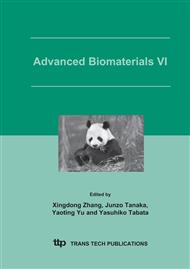p.481
p.485
p.491
p.495
p.499
p.503
p.507
p.511
p.515
A New Cellular Model for In Vitro Biocompatibility Evaluation of Microcapsule Materials
Abstract:
Fibrosis caused by the host response to long-term transplanted microcapsules and the limitation of traditional L929 cell model for biocompatibility testing inspire the development of an assay of biocompatibility based on macrophage behavior. In this paper, the human monocytic cell line THP-1 was utilized for biocompatibility evaluation of microcapsule materials. The cell viability and secretion of nitric oxide (NO) and cytokines served as index of biocompatibility were assayed. It was found that the evaluated microcapsule materials had no effect on the stimulation of NO and cytokines secretion, which meant that these materials were biocompatible. Furthermore, it suggests the THP-1 cell a convenient in vitro experimental model that might be useful for long-term predictions of material biocompatibility.
Info:
Periodical:
Pages:
499-502
Citation:
Online since:
June 2005
Authors:
Keywords:
Price:
Сopyright:
© 2005 Trans Tech Publications Ltd. All Rights Reserved
Share:
Citation:


